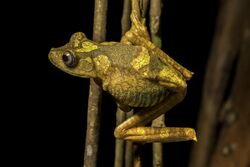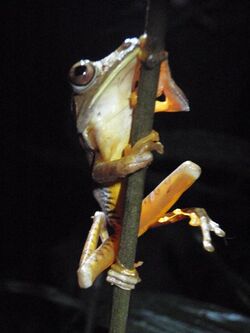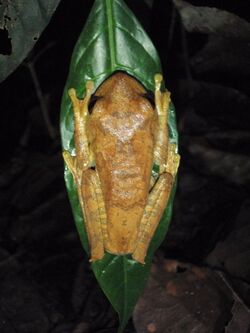Biology:Map tree frog
The map tree frog (Boana geographica) is a species of frog in the family Hylidae found in Bolivia, Brazil, Colombia, Ecuador, French Guiana, Guyana,[2] Peru, Suriname, Trinidad and Tobago, and Venezuela. Its natural habitats are subtropical or tropical dry forests, subtropical or tropical moist lowland forests, moist savanna, subtropical or tropical seasonally wet or flooded lowland grassland, rivers, freshwater lakes, intermittent freshwater lakes, freshwater marshes, plantations, rural gardens, heavily degraded former forests, ponds, and aquaculture ponds. It was previously known as Hyla geographica. The name comes from the reticulated map-like patterns on its eyelids (palpebrum). The black tadpoles congregate in dense clusters in ponds or other calm waters.[3]
References
- ↑ Claudia Azevedo-Ramos, Enrique La Marca, Luis A. Coloma, Santiago Ron, Jerry Hardy (2010). "Boana geographica". IUCN Red List of Threatened Species 2010: e.T55487A11306008. doi:10.2305/IUCN.UK.2010-2.RLTS.T55487A11306008.en. https://www.iucnredlist.org/species/55487/11306008. Retrieved 16 November 2021.
- ↑ Cole, C.J.; C.R. Townsend; R.P. Reynolds; R.D. MacCulloch; A. Lathrop (2013). "Amphibians and reptiles of Guyana, South America: Illustrated keys, annotated species accounts, and a biogeographic synopsis". Proceedings of the Biological Society of Washington 125 (4): 317–620. doi:10.2988/0006-324x-125.4.317.
- ↑ Duellman, WE; J Lescure (1973). "Life history and ecology of the hylid frog Osteocephalus taurinus, with observations on larval behaviour". Occasional Papers of the Museum of Natural History, University of Kansas 13: 1–12.
Wikidata ☰ Q2214071 entry
 |





